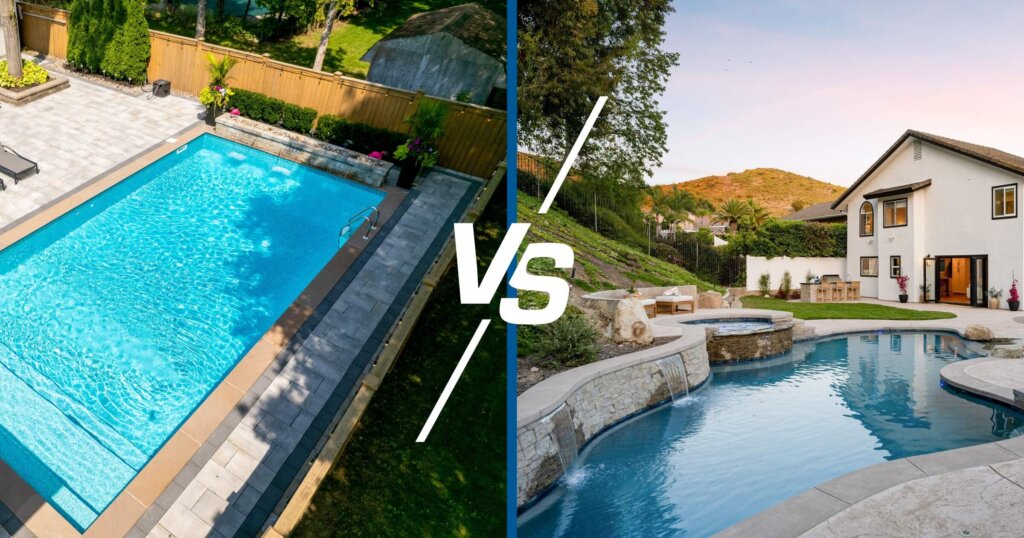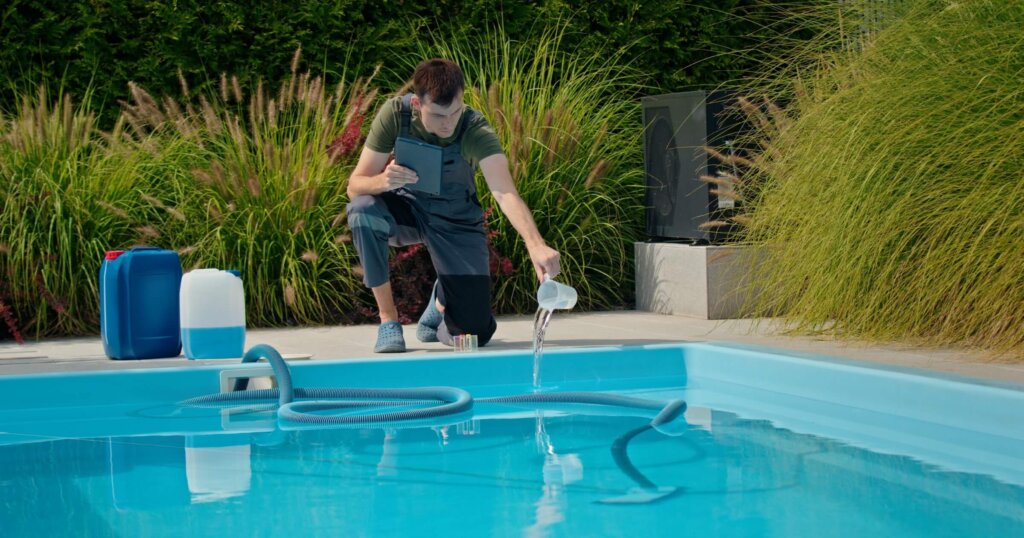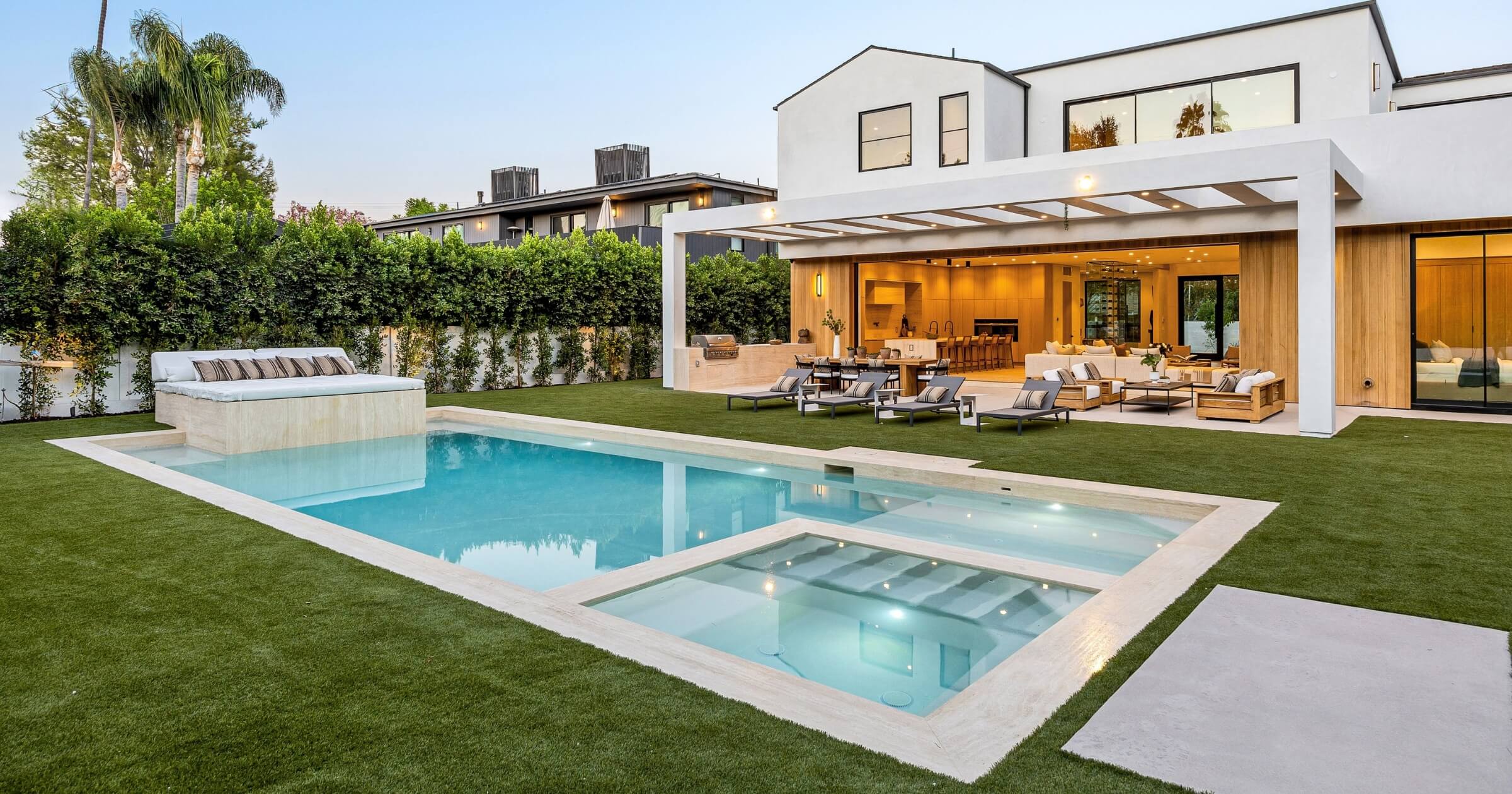The cost to build a swimming pool varies based on size, materials, location, and whether it’s a DIY or a fully managed contractor project. Whether you’re planning a basic in-ground pool or a luxury oasis, estimates can swing from about $30,000 to over $200,000 USD or $60,000 to $250,000 CAD. This article helps you analyze the cost to build a swimming pool by detailing cost factors, timelines, and ongoing ownership expenses. You’ll gain a clear roadmap to assess your budget, timeframe, and long-term financial implications.
How much does it cost to build a swimming pool: The average cost
In-ground pool cost varies significantly depending on the region and complexity. A basic in-ground vinyl pool in the U.S. starts around $30,000–$50,000, while fiberglass versions land in the $50,000–$90,000 range. Concrete or gunite installations—often custom-shaped—stretch from $90,000–$140,000+. In Canada, a vinyl installation hovers around $60,000–$100,000, and concrete builds total $150,000–$250,000 or higher in certain regions. Smaller builds with fewer bells and whistles can come in low, while ornate packages with water features and high-end decking fall toward the top.
| Tier | U.S. Cost (USD) | Canadian Cost (CAD) |
| Budget | $30,000 – $50,000 | $60,000 – $100,000 |
| Mid-range | $50,000 – $90,000 | $100,000 – $150,000 |
| Luxury/custom | $90,000 – $140,000+ | $150,000 – $250,000+ |
These figures cover main items like excavation, shell installation, equipment (filters, pumps), basic decking, and permitting. High-end elements—like waterfalls, pool houses, or outdoor kitchens—can push final costs significantly above these base ranges.
Key factors affecting the cost of pool installation
Size – bigger builds = higher cost
Pool size directly correlates to cost. A build that spans 12×24 feet may run $30,000–$48,000, while a 16×32-foot rectangle can reach $60,000–$110,000 depending on depth, shape, and equipment. Deeper sections or steep drop-offs require more sand, concrete, structural reinforcement, and longer pump runs. Larger shells also add surfacing and coping costs. For contractors, bigger footprints mean more excavation equipment, crew hours, and logistical time—all of which raise your labor and equipment rental costs.
Materials – budget vs premium options
The inner surface and shell form make a considerable difference in cost, durability, and upkeep.
| Liner material | Pros | Cons |
| Vinyl | – Lowest upfront cost – Flexible – Easy install | – Liner requires replacement every 8–12 years – Floats tear |
| Fiberglass | – Pre-fab durability, smooth surface – Easier cleaning | – Limited shapes – Higher shipping on long shells |
| Concrete/gunite | – Fully customizable shape – Long lifespan | – Most expensive setup – Requires annual acid wash or plaster repair |
Materials for decking and finishing—natural stone, brick pavers, stamped concrete—also shape final price tags.
Complexity – simple vs custom design

Photos courtesy of https://www.shutterstock.com/
Straight-edge rectangular pools cost the least and are the easiest to build. Features such as curved or organic shapes, vanishing edges, bench seats, swim-up bars, integrated lighting, or built-in grills can invite higher costs. Installing features like rock waterfalls or LED color-shifting lights may add $10,000–$25,000+, and increase build timelines due to engineering and plumbing complexities. Custom pool installations require navigating unique site conditions, reinforcing walls, and designing water management systems.
Labor – contractor pricing
Qualified pool teams typically charge $90–$250 per square foot. Large layouts in cities like Boston or Vancouver land higher than in more rural markets. Bringing the crews onsite for excavation, framing, gunite, plumbing, electrical, and finishing increases labor costs and complicates scheduling. Hard site access, rock excavation, or tight yards further increase labor time and prices. DIY installation may save on labor, but minor errors or code failures can lead to big cost overruns and compliance issues.
Location – regional differences
In high-cost metro regions, labor, permit fees, and materials cost more. A vinyl pool in Phoenix might cost $30,000, but the same one in Toronto can reach $60,000. Climate matters too: northern pools need deeper excavation, winterization, and freeze cables. Coastal or flood-zone builds may need extra wall strength or protective drainage. In Canada, everything typically runs 10–20% more than comparable U.S. builds.
Permits – local building codes
Permits for inground pools typically cost $100–$1,800, depending on size and local authority. In some areas, inspections for fences, electrical systems, and mechanical equipment add extra charges. Permit cycles can delay installation by weeks, pushing into higher-rate seasons. Skipping permits can result in fines or difficulty selling later, so skipping them is rarely worth the short-term savings.
Cost per square foot
Most pools fall in the range of $180–$350 per square foot. Vinyl liner pools are at the low end, while concrete can cost $300+ per square foot. Add-ins like glass tile, elaborate coping, or energy-efficient pumps increase per-square-foot costs further.
On average:
- Vinyl: $180–$240/sq ft
- Fiberglass: $200–$300/sq ft
- Concrete: $250–$350+/sq ft
Timeline – how long does it take to build a swimming pool?
Expect a basic vinyl pool to take 6–12 weeks, including site prep, permits, plumbing, and deck finish. Fiberglass shell builds may be completed in 4–8 weeks if delivery lines up smoothly. Concrete pools often take 12–16 weeks, due to curing, safety testing, and finish coats. Delays can stretch timelines due to permit hold-ups, weather, crew availability, or custom add-ons.
Timeline breakdown:
- Site prep and permits: 2–4 weeks
- Plumbing, electrical in-ground: 2–3 weeks
- Shell installation (set fiberglass, pour gunite): 1–2 weeks
- Finishing touches, decking, and coping: 2–4 weeks
- Curing, filling, inspections: 3–8 weeks
Expect around 3–4 months for traditional inground pools, with variations based on season, material shipping, and local inspection backlog.
Excavation complexity
Not all yards are equally easy to dig. If the site has rocky terrain, heavy clay, tree roots, or sits on a steep slope, excavation becomes more time-consuming and expensive. Builders often need specialized machinery or blasting tools, which can add $5,000–$15,000 to the cost to build a swimming pool. These costs are often unpredictable until excavation begins, so it’s wise to build a contingency buffer if your site is less than flat and open.
Water features and heating
Many homeowners want their pools to feel like a personal resort, and features like waterfalls, laminar jets, or spa heating systems make that happen—but they come at a price. A pool heater alone ranges from $3,000 to $7,500, depending on whether it’s gas, solar, or electric. Additions like bubblers, fountains, and LED-lit waterfalls can run anywhere from $500 to $5,000, depending on complexity. These features also require extra plumbing, wiring, and maintenance, so they affect long-term costs, not just installation.
Decking and landscaping
The area surrounding your pool affects both its usability and final cost. Bare brushed concrete is the cheapest option, but most homeowners opt for stamped concrete, stone pavers, or even wood decking for improved look and comfort. Depending on material choice and yard size, decking and surrounding landscaping can cost between $3,000 and $25,000 or more. If you’re adding planters, lighting, or retaining walls, expect higher totals and longer timelines.
Fence and pool cover
Most municipalities require safety barriers for any in-ground pool, especially if children or pets are on the property. Installing code-compliant fencing with locking gates can cost anywhere from $2,500 to $8,000, depending on the material and length. Automatic pool covers, which enhance safety and help reduce debris, range from $1,200 for basic manual options to over $15,000 for motorized retractable models. Skipping these requirements can delay permits or create legal issues during resale.
Smart pool automation
Many modern pool systems can be controlled from a smartphone or tablet, making daily operations easier and more efficient. These automation systems—ranging from $2,500 to $8,000—allow users to schedule cleaning, adjust heating, monitor chemical levels, and control lighting from anywhere. They’re popular with second homeowners and busy professionals looking to minimize hands-on maintenance. However, they still require proper installation and ongoing app updates or service contracts.
Annual energy use
Pumps, filters, and heaters are all energy-hungry, and running them daily—especially during the summer—adds up. Most pool owners spend between $1,200 and $3,500 per year on electricity, depending on usage, pool size, and local rates. Using solar-powered pumps or variable-speed motors can help reduce this, but those upgrades have higher upfront costs. Homeowners should factor energy into both their annual maintenance budget and daily operating choices.
Winterization in cold climates
If you live in a northern region where winter temperatures drop below freezing, closing the pool properly is essential. Expect to spend $500–$1,200 annually on winterization, including draining pipes, applying anti-freeze, covering the pool, and securing mechanical systems. Improper winterization can lead to pipe bursts, cracked tiles, or damaged pumps, which are expensive to repair. Hiring a professional for this step is common unless you’re an experienced pool owner familiar with your system’s specs.
Things to consider before installing a pool

Photo courtesy of https://www.shutterstock.com/
Maintenance costs
Pools need yearly budgets for chemicals, rocks, filter cleanings, liner replacement (vinyl), maintenance, and energy costs—typically $1,200–$2,500 annually. Concrete pools demand more chemicals to balance pH. Don’t budget alone—add an insurance bump to cover liability and equipment damage.
How often you use it
If you use the pool infrequently, a small in-ground or portable above-ground model might suffice. Swimmer or therapy pools benefit from heating and reliable filtration, but these options can substantially increase your operating costs. Matching the pool to usage helps balance the build cost versus benefits.
Water drainage in the off-season
In full winter zones, you’ll need pump covers, winter kits, and board-up gear. Climate-safe winter protocol protects the liner and piping during freeze cycles. Skip this step, and you could end up spending thousands on spring repairs. Seasonal shutdown planning is a serious expense, not just a chore.
In-ground vs above-ground pools
Portable or semi-inground kits cost $1,500–$5,000, require less excavation, and do not need permanent permits. Suitable for small yards or budgets. These units can use standard filtration and are easy to dismantle. But resale value rises much more with inground pools. Your final decision should reflect long-term use, maintenance willingness, and site conditions.
Long-term pool ownership
Value and equity
In hot climates, inground pools can add 5%–8% to home value. In colder markets, returns are smaller. A well-executed build with beautiful landscaping may still boost appeal and resale value significantly.
Insurance
Adding a pool may raise your homeowner’s liability insurance by $100–$500 annually. Some lenders require fences or safety covers to limit rate increases.
Energy efficiency
Invest in solar heaters, energy-saving pumps, insulating covers, and LED lighting. While they raise upfront installation costs, savings on power bills can offset them in 5–7 years, and they contribute to lower carbon footprints.
Financing a pool build
Common funding options:
- HELOC or home equity loan: low interest, but secured against your home
- Cash-out refinance: rolls pool cost into mortgage
- Personal loan: quick but with higher interest rates
- Savings: interest-free method, but requires strong cash flow
Always build in a 10%–20% contingency buffer. Hidden costs, such as bedrock excavation, engineering fees, or design revisions, often pop up and increase the cost to build a swimming pool in your backyard.
Like this and want more just like it? Check out these reads:
- How to build earthquake-resistant buildings
- Highway construction cost in 2025
- Cost to build a barndominium
- How much money does a dam cost?
- How much does it cost to build a house in the U.S?
Thinking about installing a pool or doing a landscape renovation? Subscribe to the Under the Hard Hat newsletter for budgeting tools, jobsite updates, and resource breakdowns.


